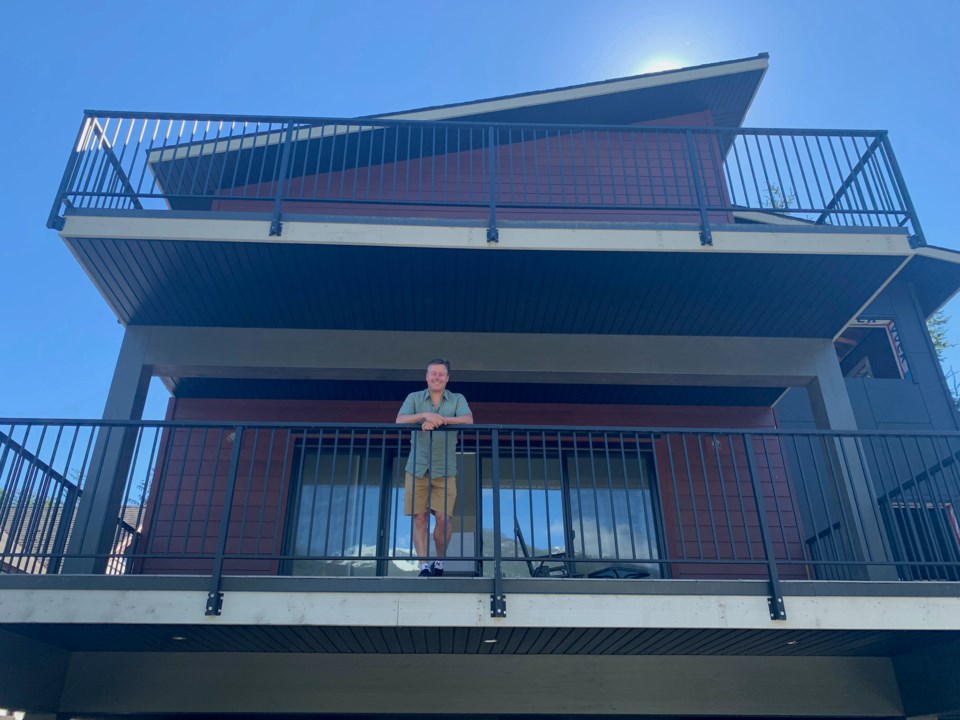Nobody denies it’s a pressing problem.
As Squamish continues to grow at a speed three times the provincial average, it has become urgently clear that there simply aren’t enough homes for the growing population to move into. These growing pains are having a knock-on effect on employment, rent prices and even homelessness—while some are choosing to flee the Sea to Sky Corridor altogether in search of appropriate housing.
According to the Housing Needs Report released by Squamish in 2023, projections estimate there will be 9,600 new households by 2036. To accommodate this growth, a minimum of 6,840 new housing units are needed by 2031, requiring an average of 685 units to be built every 12 months. However, only 217 houses broke ground last year—so what’s the hang-up?
The Squamish Premium
It’s not always easy to make your dream a reality.
For developer Dave Ransier, who has been building homes in Squamish since 1992, the process to acquire a permit and get to work has been unnecessarily labyrinthine in the past few years, and he feels the red tape and roadblocks are getting in the way of meeting an urgent community need.
“My interactions with the District have been challenging. We all seem to have similar goals, but how we achieve them is often at odds. My advice to anyone wanting to navigate this process is, to be patient,” he told The Squamish Chief.
“It is going to take a lot longer than you think, and it is going to be a lot more expensive than you think.”
That’s the same feedback shared in the housing report, which emphasized current market challenges for developers and builders.
“With increasing interest rates, cost escalations, and supply chain issues, it is difficult to make new projects financially feasible. Building in Squamish comes at an additional premium, as many of the tradespeople needed to construct new homes must travel from other areas,” the report reads.
“Development Liaison Committee members defined this specific challenge as the ‘Squamish premium.’”
Ransier’s latest endeavour is called the Responsible Living project, which came about in response to the housing crisis and the current permitting process, he said. He aspires to build homes for people with average incomes, typically townhomes, but he says the road to a green light has been fraught with frustration.
“The permitting process for townhomes and apartments is slow and expensive. It is much simpler to build a single-family or duplex home. You just need a building permit, no need to consult the planning department or the engineering department. No rezoning, no development permit, no service agreement and no land development agreement. No multi-year delays which add 20% or more to the cost of delivering a home,” he said.
“This form of housing is small so it fits within the existing neighbourhood and does not require an expensive, time-consuming rezone.”
He doesn’t think the process has to be this way.
“We need to completely rethink the process. I suggest we begin by aligning zoning with the Official Community Plan or Neighbourhood Plans. Additionally, we should reserve development permits for large-scale projects, as originally intended.”
Ransier feels the crisis ultimately isn’t just a local issue.
“While local initiatives play a crucial role, the housing crisis is provincewide. This can’t be solved one community at a time. People forget that housing is a provincial responsibility that is delegated to the municipalities,” he said.
“The province has demonstrated a willingness to intervene to address housing supply challenges, as seen in recent mandates for fourplex houses and automatic apartment zoning near SkyTrain stations. These initiatives are positive steps, but further action is needed at the local level to streamline the process.”
Squamish Housing Action Plan
The District of Squamish isn’t sitting on its hands.
According to senior director of community development Jonas Velaniskis, the government is taking a multi-pronged approach to encouraging development and getting houses built. That’s why, in February 2024, the District council endorsed the Squamish Housing Action Plan, which aims to accelerate construction.
“It is anticipated that Squamish’s population will continue to grow at a rate above the B.C. average. There is a need to continue to build to meet this growing need for new housing units,” Velaniskis told The Squamish Chief.
Some of the ways they’ve attempted to stimulate development include:
- Updating residential zoning to remove regulatory barriers to infill housing.
- Two design contests (one for multiplexes and one for accessory dwelling units) to generate interest, inspiration, and options for the construction of new units.
- Increased permitting capacity by adding additional positions to process servicing agreements and development permits.
- Amended zoning District-wide to permit affordable housing to be constructed anywhere if the flood risk is manageable.
- Reduced development permit requirements for new multi-unit developments, and removed the requirement of a development permit for triplexes and fourplexes.
- Waived planning fees for new affordable housing projects.
The District also prioritized applications that are either 100% rental housing or 30% affordable housing, which reduces processing times. They’ve removed community amenity contribution targets for new rentals and are continuing to fund the Squamish Affordable Housing Society.
But even when everything looks good on paper, they have to keep in mind the environmental considerations.
“Development in Squamish is affected by the need to balance growth with protection against natural hazards such as wildfires, floods and debris flows, which affect certain areas throughout Squamish,” Velaniskis said.
“Areas affected by the presence of natural hazards have limits to density and additional requirements for development, which in turn can affect the feasibility of some developments.”
Breaking through the bottleneck
Building homes can be more expensive than you think, and the process more laborious. But according to Ransier, it doesn’t have to be that way.
“The Engineering Department can also be a major bottleneck in the process. Single-family homes don’t need an expensive servicing agreement, but a four-plex on the same lot does. The service agreement is completely at the discretion of staff. This can add hundreds of thousands of dollars in costs and cause year-long delays,” he said.
He said this process shows a preference for one type of development over another and isn’t fair.
“This really needs to be removed and (there should be) a simple-to-understand flat rate that everyone pays. For clarity, it should be paid by the wealthy people who can afford multi-million dollar single-family homes as well, not just people of more modest incomes that live or rent in a four-plex, a townhouse or an apartment.”
He believes this flat rate could be used to upgrade high-priority roads and sidewalks in the community.
Ransier also feels the current system for community amenity contributions needs to be revisited.
“The name is somewhat misleading, as only one-third of the funds are allocated to community amenities. The remaining two-thirds support the District’s various affordable housing programs. This portion is currently calculated at 6% of the final sales price. For example, a new $1.2 million townhouse would incur a $72,000 affordable housing fee.
“This CAC is enforced during the rezoning process, which may explain why zoning is not aligned with the Official Community Plan. Furthermore, the CAC does not apply to wealthy individuals who can afford multi-million dollar single-family homes, as they do not require rezonings.”
He thinks there must be a better way.
“While recreational and cultural amenities are essential for our quality of life, burdening only people of modest incomes who live in townhomes and apartments with these Affordable Housing Fees, which make housing unaffordable seems counter-productive.”
No need to expand
Squamish has enough room for everybody.
Though some communities have to develop beyond their current zoning borders to address the housing crisis, Squamish currently has more than enough land to accommodate the need, according to Velaniskis.
“The District has increased zoning flexibility, removed regulatory barriers for missing middle units, and increased staff to process applications. The District is unable to control macroeconomics; things such as interest rates, construction costs and labour availability are large challenges to meeting these goals,” he said.
With affordable housing in mind, the District provided land for housing projects Spirit Creek and Under One Roof, and supported the development process. These projects have created 121 units.
The District also supported a partnership between BC Housing, Polygon and the Squamish Seniors Housing Society by waiving all their fees. This supported the construction of 232 affordable senior rental units at Westwinds.
According to Velaniskis, the permitting process involves guiding developers and helping them to meet the existing provincial standards.
“The District doesn’t necessarily reject either building permit applications or development permit applications but assists and ensures that applications meet District policies, bylaws and the BC Building Code,” he said.
“Larger development projects are encouraged to book a pre-application meeting with the planning department to discuss the feasibility of a potential project before application.”
Think creative
One roadblock to getting things built is infrastructure.
Just like many communities in B.C. and across Canada, Squamish has aging infrastructure that requires upgrading—and that requires significant cash.
“The District has developed infrastructure master plans to meet the needs of the community; however, it takes time, decades, to implement major capital plans. Servicing for new developments is regulated through the Subdivision and Development Control Bylaw,” Velaniskis said.
“New developments must ensure that the existing infrastructure can adequately accommodate the additional load—which includes things such as water pipes, sanitary systems, stormwater collection/drainage, and frontage. The cost of upgrading that infrastructure falls to both the District’s capital plans and new developments. Where development needs to proceed in advance of the District’s capital program, the costs are borne by development.”
Velaniskis said the community needs creativity and innovation to navigate the coming years.
“Community planning seeks creative opportunities to integrate housing throughout the District. Community planning is focused on housing-first actions and policies to help tackle the housing crisis.”




